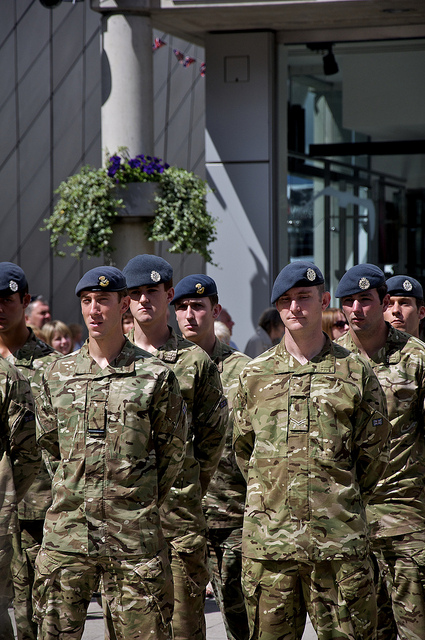 Following a new announcement of cuts to the UK armed forces, many are asking whether we are seeing Britain’s defence capabilities in decline. Andrew Dorman warns against simply focusing on focus on numbers or money. There is no direct relationship between amount spent or size of the armed forces and the security of the nation or between numbers of personnel and capability. Also, focusing on the armed forces is also problematic given that in many ways the battlefields of today and tomorrow are different.
Following a new announcement of cuts to the UK armed forces, many are asking whether we are seeing Britain’s defence capabilities in decline. Andrew Dorman warns against simply focusing on focus on numbers or money. There is no direct relationship between amount spent or size of the armed forces and the security of the nation or between numbers of personnel and capability. Also, focusing on the armed forces is also problematic given that in many ways the battlefields of today and tomorrow are different.
Last week was full of bad news for defence. A report by the House of Commons Defence Committee was highly critical of the coalition’s government’s preparation for the next Strategic Defence and Security Review. In part the report continued the debate on strategy making within the Ministry of Defence first started in International Affairs but in this case following the Lindley-French line of divorcing the link between ends and the means to achieve those ends. The Defence Secretary, Philip Hammond, also announced the fourth tranche of redundancies that have befallen the UK’s armed forces since the coalition government came to power in 2010. As a result, the regular army will be reduced from 102,000 in 2010 to 82,000. The other two services have suffered comparable cutbacks.

(Credit: Amplified Group CC BY 2.0)
A month earlier, at the annual Chief of Defence Staff lecture at the Royal United Services Institute, General Sir Nick Houghton had indicated that any further cuts would have a disproportionate effect on the United Kingdom’s ability to use military power. The future construct of the UK’s armed forces – Future Force 2020 – is predicated on defence spending that will increase by 1-2 % per year in real terms from 2015 and the Ministry of Defence managing to keep its costs under control. Neither looks likely, the current coalition government have pledged to increase the amount spent on equipment by some 1% but have made no commitment about the overall defence budget.
Moreover, the ongoing reforms have run into difficulties. The planned transfer of the Defence Equipment and Support organisation to private operation failed as the number of bidders declined to one whilst there is little evidence that the Ministry of Defence has managed to overcome the increasing top-heaviness of its military first identified in 2009 as a parliamentary answer confirmed (cols.604-8W). Moreover, in his Autumn statement the Chancellor, George Osborne, confirmed that Britain’s structural deficit has not been resolved and that there would need to be additional cuts to public spending. The general assumption within Whitehall is that defence got off lightly in 2010 and that it should be expected to undergo significant reductions in the future. Thus, the planned regular army of 82,000 looks optimistic at best.
Yet, within NATO, the United Kingdom is proportionately one of the highest spenders barely managing to meet the NATO target of 2% of GDP on defence. So are we seeing Britain’s defence capabilities in decline? Three points need to be borne in mind before such an assumption is made. First, there is no direct relationship between amount spent or size of the armed forces and the security of the nation. Defence spending in large part is directly linked to the threats and fears that a nation and its people feel confronted by. In many respects the United Kingdom has never been safer, the government’s own National Security Strategy indicates that many of the challenges before the United Kingdom are no defence related, there is no Soviet Union and thus in a period of relative peace the funding allocated to defence can logically fall. It is worth noting that, for the first time since the 19th century, the British Army is facing the prospect of being stationed almost entirely in the United Kingdom without a defined threat to prepare for. The British Army does not know how to deal with peacetime.

(Credit: Martin Pettitt CC BY 2.0)
Second, there is no direct link between numbers of personnel and capability. There are two other factors at play. First there is the qualitative element in calculating military capability. For example, both the United Kingdom and Portugal main a marine brigade but few suggest that they are comparable. The Royal Marines 3 Commando Brigade is an elite fighting unit with few peers. Thus, whilst the number of strike aircraft in the Royal Air Force’s inventory today is much smaller than at the time of the First Gulf War in 1991 or the Kosovo War in 1999 their capability is far greater. Today’s Tornados can strike with precision in all weathers unlike the same aircraft a decade ago thanks to the weapons with which they are now equipped. Similarly, a British Army infantry battalion today can generate far greater firepower than its World War 2 counterpart. Secondly, there is the question of intent, how prepared is the government to use its armed forces. With a toxic legacy of Afghanistan and Iraq there must be serious questions about whether the government will be prepared to use force unless in response to a 9/11 happening in the United Kingdom.
Third, focusing on the armed forces is also problematic. In answering questions on the latest personnel reductions Philip Hammond rightly pointed out that in many ways the battlefields of today and tomorrow are different. At the start of this millennium few were putting the case for cyber defence yet for many nations cyber warfare is the principle focus and this requires different types of forces.
This leaves one to conclude that a simple focus on numbers or money is merely to focus on an input measure that may bear little relationship to the output that can be generated. Thus, whilst the capabilities of Britain’s armed forces may not be diminishing as starkly as the numbers might suggest, there is a serious question mark hanging over the future use of military force by this and future British governments.
Note: This article gives the views of the author, and not the position of the British Politics and Policy blog, nor of the London School of Economics. Please read our comments policy before posting.
About the Author
Andrew Dorman is a Professor in International Security and an Associate Fellow at the Royal Institute of International Affairs, Chatham House. His research focuses on decision-making and the utility of force utilising the case studies of British defence and security policy and European Security.







I agree with your article, except when you talk about the Portuguese forces. We are a small nation (10 million people) but we always had some very good soldiers. Currently we have a small but professional army, with one or two fine elite units. Remember that some decades ago our armed forces fought and largely won a 13 year long war in Angola, Mozambique and Guinea, beating soviet and chinese backed guerrillas. And just like Britain (our oldest ally), we don’t loose a war for centuries. Our last defeat was against Spain, in 1802, and since that we fought in numerous wars, including the Napoleonic Wars and WWI. You are probably right: the Portuguese marine corps is weaker than you Royal Marines 3 Comando. But our boys would give them a hard fight, like the Argies (other long time underestimated nation) did in the Falklands.
Andrew
This was a good article which perhaps sums up the challenges at the heart of the UK military today. Namely, how best to respond to a threat which no longer requires bigger battalions but deeply specialist individuals, while dealing with a media and public opinion fixated on the notion that more is somehow ‘better’ without considering what ‘better’ actually means.
The look ahead for defence would seem to suggest that what is needed is a predominantly expeditionary force with strong investment in the sort of high end niche capabilities like carrier strike, special forces and ISTAR etc which generates real value to our coalition partners. But until the media and public debate can move beyond the notion that having an army of 82000 which we can afford and send somewhere is probably better than an army of 100k which we cannot afford and would not be able to send somewhere then moving the terms of the defence debate forward is just not possible. We are too fixated on what we could hypothetically do in the past without pausing to consider that today we are probably far more capable in terms of achieving effect than ever before.
I think CDS summed it up nicely in his Christmas speech to the RUSI, which I critiqued at http://thinpinstripedline.blogspot.co.uk/2013/12/what-general-said-next-cds-2013-rusi.html